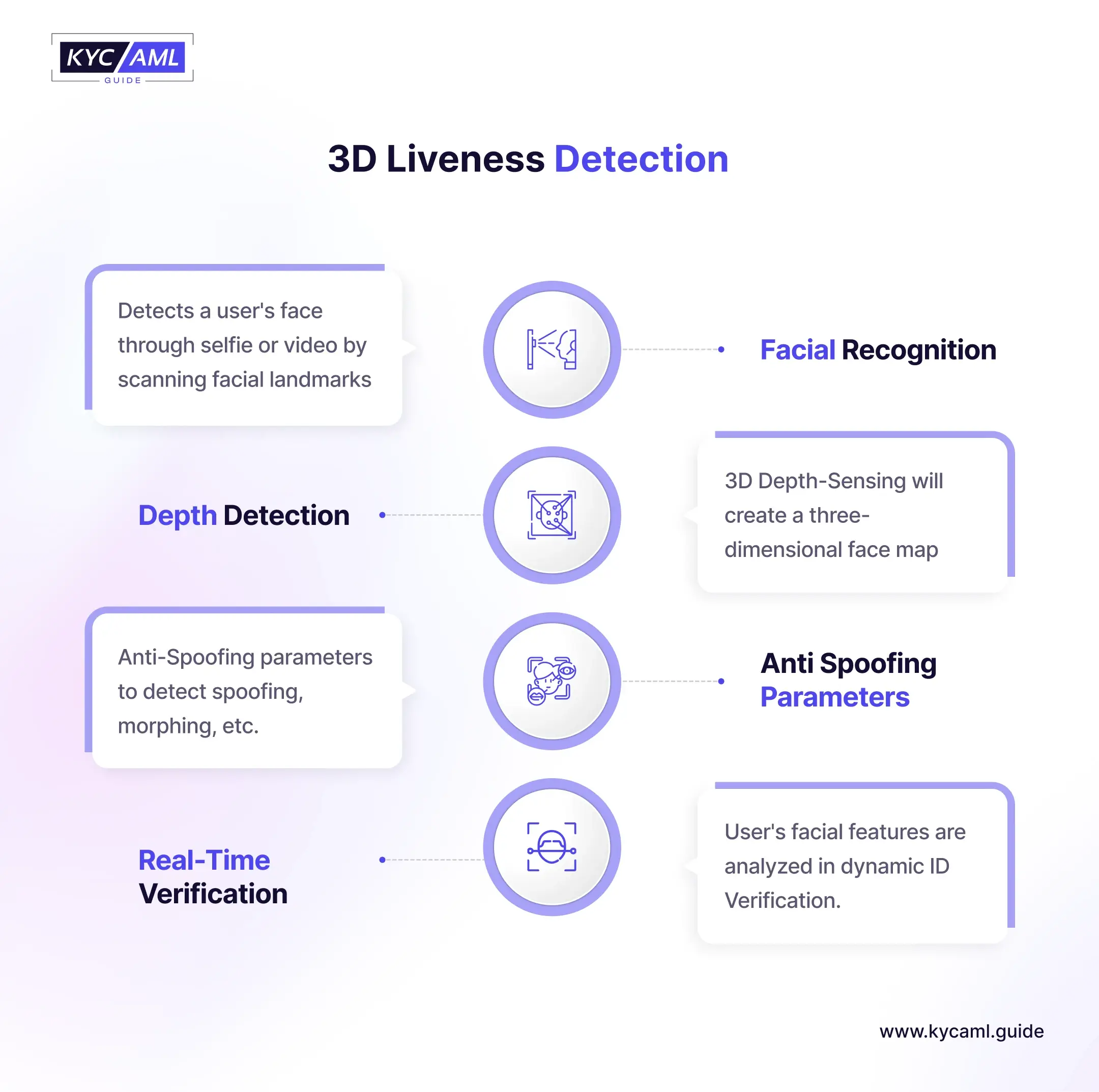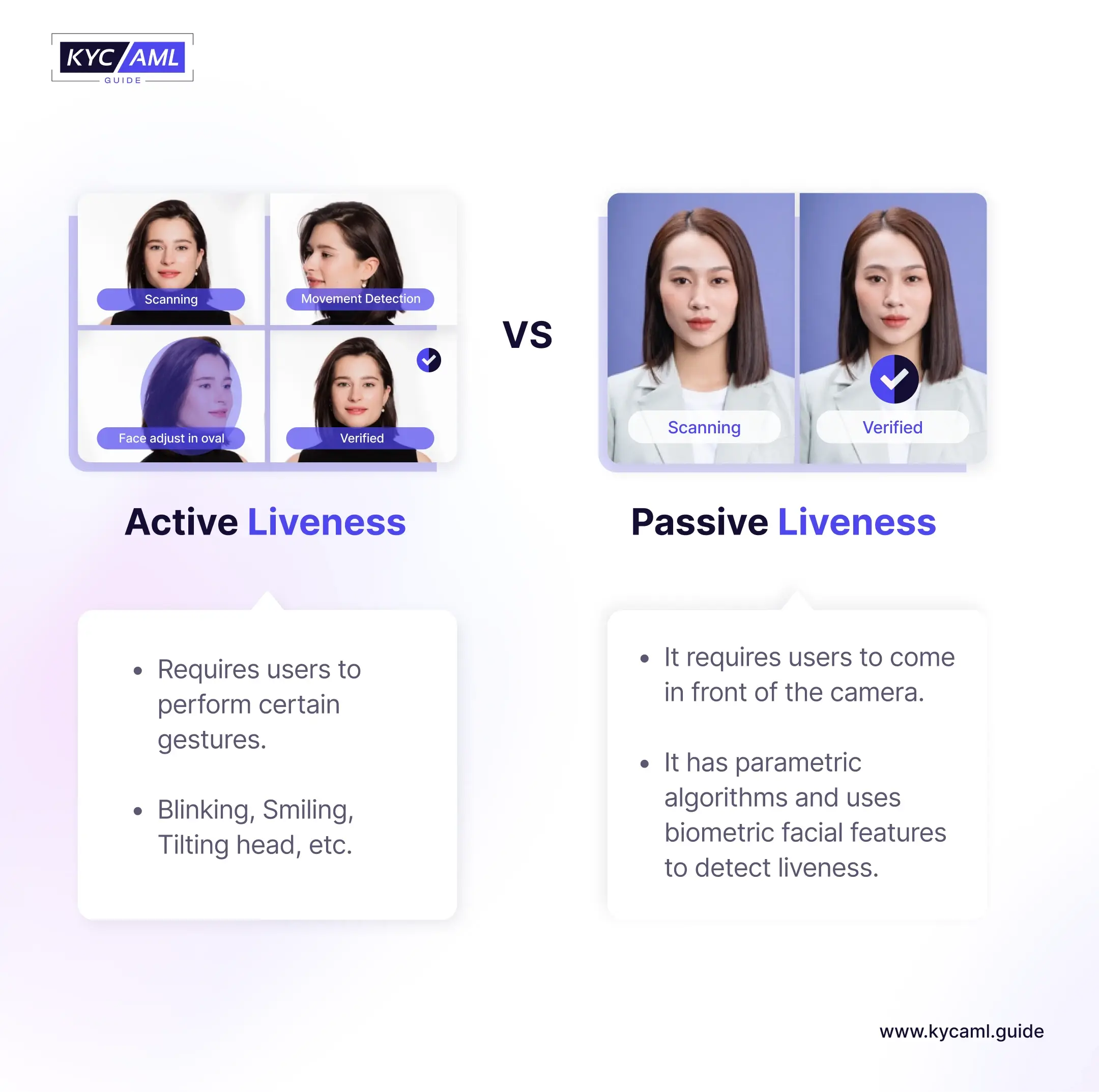“Passiveness is important in 3D Liveness Detection because it relies on involuntary human cues and they’re secret, things that hackers can’t identify and try to program some type of a deepfake around it but it is difficult to Spoof.” (Jay Meier, Facetec Inc.)
Understanding 3D Liveness Technology in KYC
3D Liveness Identity Verification is a distinct type of biometric verification used to confirm that the person being identified is alive and personally sitting in front of the biometric detection device and personally confirming the identity. In contrast with 2D Liveness Detection which uses static images, 3D Liveness guarantees an in-depth scanning and view of the person’s face by capturing the dynamic facial features through different technologies.
Here is an illustration of the main components of 3D Liveness Detection in real-time:

| Facial Recognition |
|
| Depth Detection |
|
| Anti-Spoofing Parameters |
|
| Real-Time Verification |
|
Active and Passive Liveness; Which one is Better for 3D KYC?

Active Liveness requires a user to perform specific actions upon instruction during KYC Identity Verification through video. It may instruct the user to tilt the head, blink, or smile in front of the camera to prove his or her liveness.
On the other hand, Passive Liveness Detection scans distinctive and specific biometric features like habitual blinking and skin patterns. These are referred to as involuntary cues by Jay Meier in a recent webinar by KYC AML Guide quoted at the beginning of this blog post. He advocates Passive Liveness because it is difficult to mimic or spoof anyone. The viewpoint is that a benchmark 3D Liveness Detection in KYC should have an AI that measures 60 to 70 parameters or aspects of a human face including its three-dimensionality. Hackers may try to program a deepfake near that approach but it can’t be as realistic as a Passive Liveness check is carried out. He also mentioned that AI can easily spoof the Active Liveness cues as they are easily predictable and mostly the same in a specific IDV Solution. Passive Liveness is a much safer option as it randomizes the attack factors where hackers get confused and don’t know what to spoof.
Benefits of 3D Liveness Detection
1) Prevention of Identity Spoofing and Morphing
3D Liveness Checks play a vital role in detecting identity spoofing and Facial Morphing Attacks. These two methods of fraud are rapidly evolving but 3D Liveness Detection can detect and mitigate these.
2) Reduced False Positives and False Negatives
3D Liveness detection enables a KYC Solution to reach its highest potential in detecting fraudulent identities correctly. This increase in the accuracy of a KYC Tool is due to reduced False Acceptance and False Rejection.
3) Adaptability to Different Environments
3D Liveness Detection can perform better than 2D Identification as it can detect identities in varying conditions like low and bright lighting, distance from the camera, and edges. This 3D Face mapping enhances the applicability and accuracy of the KYC Tool.
4) User Experience
User Experience is enhanced due to 3D Liveness Detection as it is designed to enhance the User Journey and seamlessly onboard genuine users. It is an essential component in any KYC Technology.
Challenges in 3D Liveness Detection
KYC Identity Verification Tools can face some challenges in integrating 3D Liveness Detection.
- The cost of integrating 3D Liveness Detection can be an issue as KYC Tools need to upgrade their existing technologies, deploy new systems, and train their teams accordingly.
- User Acceptance can be a challenge as 3D technology can raise concerns about data privacy and security.
- Diversity of User characteristics can be a challenge for 3D Liveness Detection where ethnicity, age, and other facial features can raise a concern of bias, and inclusivity.
- Continual adaption to newer ways of spoofing and morphing attacks can also be challenging for KYC Tools in 3D Liveness Detection.
How KYC Solutions Can Improve 3D Liveness Detection in Real-Time?
As a KYC Tool Provider, the first and foremost step is to get your KYC Tool tested by an expert consultancy to measure the accuracy and efficiency of the 3D Liveness Detection feature. KYC AML Guide’s Vendor Analysis is a tool that can help scale KYC Solutions as per benchmark performance. We can guide fintech companies based on our comparison of these tools to select the most suited Solution for their business. Moreover, KYC Tools can use this as a litmus test and find the key areas of improvement, especially in enhancing their 3D Liveness Detection.
Lastly, in 3D Liveness Detection, there’s no debate about Active or Passive Liveness. The rule-based 3D Liveness verification requires a system that can’t be spoofed. For this purpose, the Identity Verification Tools can consider introducing newer technologies for 3D Liveness Detection making their systems stronger against identity theft.
Also Read: How to Detect a Fake ID? | KYC AML Guide





